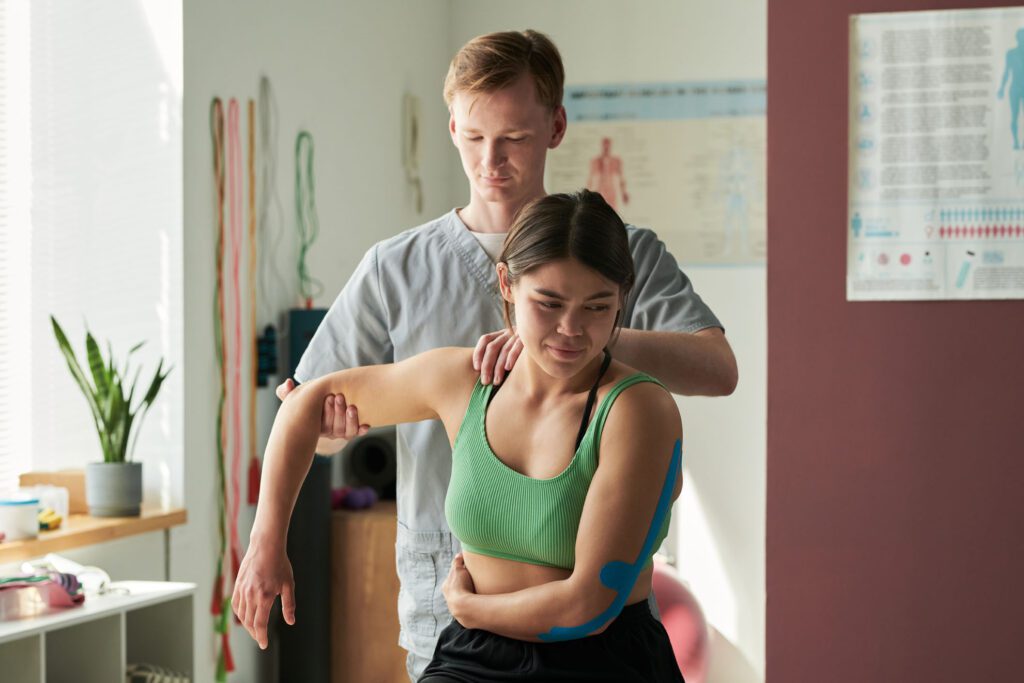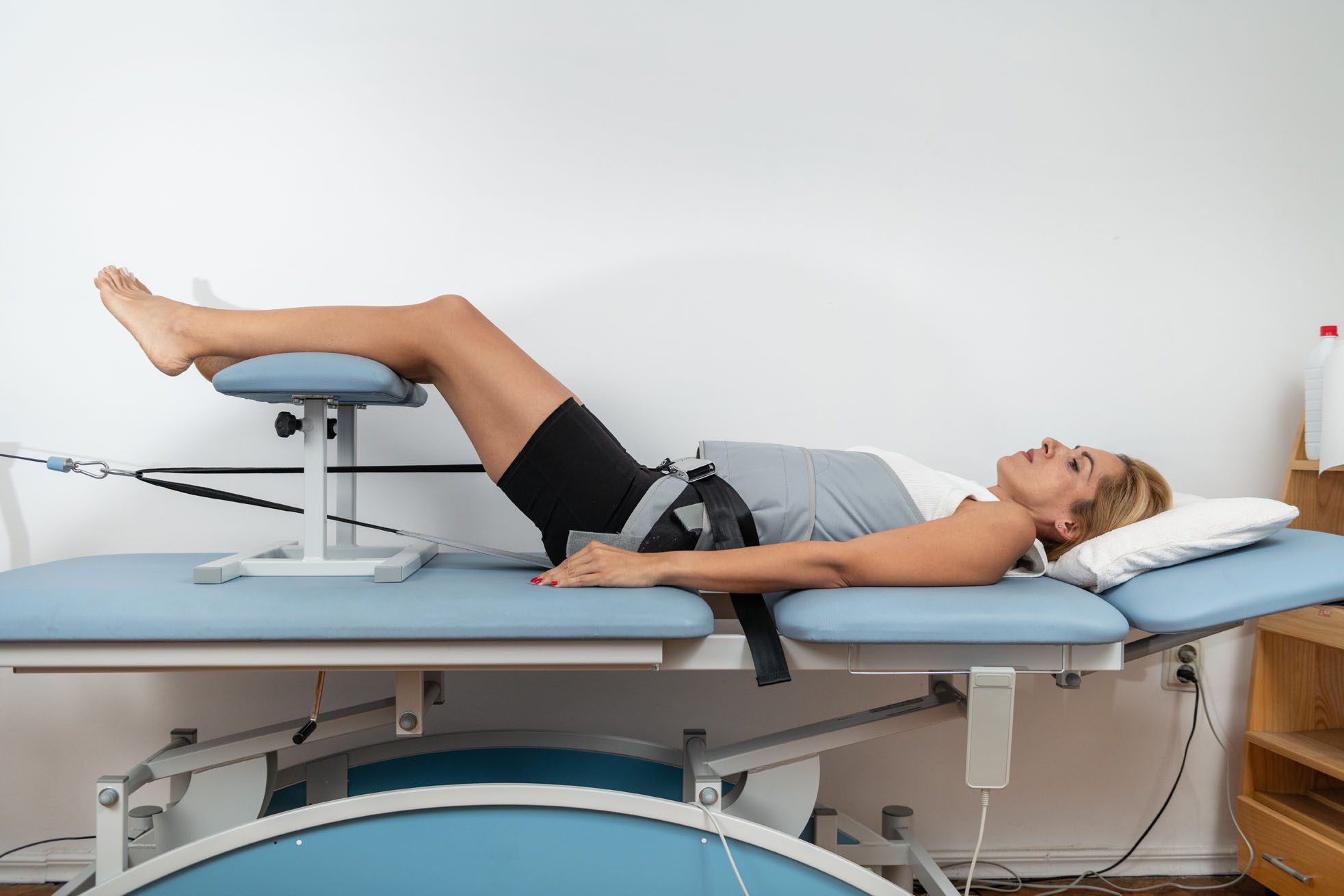18-Wheeler Accidents: Understanding Spinal Injuries and Recovery Options

Introduction
18-wheeler accidents are among the most devastating events on the road due to the massive size and weight of these vehicles. The sheer force of a collision can cause severe injuries, particularly to the spine and musculoskeletal system. These injuries range from mild sprains to life-altering spinal cord damage, impacting victims’ mobility, quality of life, and long-term health. This article explores the types of spinal injuries caused by 18-wheeler accidents, including fractures, herniated discs, and sciatica. It highlights the integrative treatment approaches used by professionals like Dr. Alexander Jimenez to promote recovery. By addressing root causes and using advanced diagnostics, chiropractic care and integrative medicine offer hope for restoring health and supporting legal claims.
Common Spinal Injuries from 18-Wheeler Accidents
Spinal Fractures
The immense force of an 18-wheeler crash can cause spinal fractures, which are breaks or cracks in the vertebrae. These injuries vary in severity, ranging from stable fractures that may heal with rest to unstable fractures that require surgery. Fractures often occur in the cervical (neck), thoracic (mid-back), or lumbar (lower back) regions of the spine. Symptoms include intense pain, swelling, and limited mobility, with severe cases leading to nerve damage or paralysis (Wyatt Law Firm, n.d.). For example, a compression fracture in the lumbar spine (L1-L5) can cause pain, numbness, or weakness in the legs, hips, or groin (SpinalCord.com, n.d.).
Spinal Cord Injuries
Spinal cord injuries (SCIs) are among the most severe outcomes of 18-wheeler accidents. The spinal cord, a bundle of nerves running through the spine, can be bruised, torn, or severed, leading to partial or complete loss of function. Complete quadriplegia, often permanent, results from high cervical injuries and affects the arms, legs, and torso (CK Legal, n.d.). Incomplete SCIs may cause chronic pain, mobility challenges, or loss of sensation in the limbs (Mayo Clinic, 2024). Emergency symptoms include numbness, tingling, or weakness in the extremities, requiring immediate medical attention (Mayo Clinic, 2024).
Herniated Discs
A herniated disc occurs when the soft inner material of a spinal disc pushes through its tough outer layer, often due to the sudden impact of a truck accident. This can irritate nearby nerves, causing pain, numbness, or weakness in the arms or legs, depending on the disc’s location (Complete Injury Management, n.d.). Herniated discs in the lumbar spine are particularly common and may lead to sciatica, characterized by radiating pain down the leg (Chiropractic Tucker, n.d.).
Sciatica and Nerve Compression
Sciatica is a condition where the sciatic nerve, which runs from the lower back through the legs, is compressed or irritated, often by a herniated disc or spinal stenosis (narrowing of the spinal canal). Symptoms include sharp, burning pain radiating from the lower back to the buttocks and legs, along with tingling or numbness (Inspired Spine, n.d.). Spinal stenosis, caused by trauma or degenerative changes, can also pinch nerves, exacerbating sciatica symptoms (Spine-Health, n.d.). 18-wheeler accidents can trigger or worsen these conditions due to the intense forces involved (Your PGH Lawyer, n.d.).
Whiplash and Soft Tissue Injuries
Whiplash, a common injury in rear-end collisions, occurs when the neck is rapidly jerked back and forth, straining muscles, ligaments, and tendons. Symptoms include neck pain, stiffness, headaches, and dizziness (Victims Lawyer, n.d.). While whiplash is often considered a soft tissue injury, it can also contribute to spinal misalignments or disc issues, leading to nerve compression and radiating pain (Sea Change Chiropractic, n.d.).
References
CK Legal. (n.d.). Spinal cord injuries from trucking accidents. https://cklegal.com/spinal-cord-injuries-from-trucking-accidents/
Complete Injury Management. (n.d.). The 6 common types of spine injury from a car accident. https://www.completeinjurymanagement.com/the-6-common-types-of-spine-injury-from-a-car-accident/
Inspired Spine. (n.d.). Radiculopathy. https://inspiredspine.com/conditions-treatments/conditions/radiculopathy/
Mayo Clinic. (2024). Spinal cord injury. https://www.mayoclinic.org/diseases-conditions/spinal-cord-injury/symptoms-causes/syc-20377890
SpinalCord.com. (n.d.). Lumbar (L1-L5) vertebrae spinal cord injury. https://www.spinalcord.com/lumbar-l1-l5-vertebrae-spinal-cord-injury
Spine-Health. (n.d.). What is spinal stenosis? https://www.spine-health.com/conditions/spinal-stenosis/what-spinal-stenosis
Victims Lawyer. (n.d.). Spinal injuries caused by car accidents. https://www.victimslawyer.com/practice-areas/car-accidents/car-accidents-injuries/spinal-injuries-caused-by-car-accidents/
Wyatt Law Firm. (n.d.). Spinal cord paralysis injuries. https://www.wyattlawfirm.com/truck-accident/spinal-cord-paralysis-injuries/
Your PGH Lawyer. (n.d.). What is the number one injury for truck drivers? https://yourpghlawyer.com/what-is-the-number-one-injury-for-truck-drivers/
Chiropractic Tucker. (n.d.). Can a car accident cause sciatica? https://www.chiropractictucker.com/can-a-car-accident-cause-sciatica/
Sea Change Chiropractic. (n.d.). Car crash injury rehab: The roles of chiropractic, rest, and exercise. https://seachangechiropractic.com/car-crash-injury-rehab-the-roles-of-chiropractic-rest-and-exercise/[](https://chiropracticscientist.com/personal-injury-chiropractic-care-el-paso-texas/)
Focus Keyphrases: spinal cord injuries, herniated disc symptoms, sciatica nerve pain, whiplash injury treatment
Dr. Alexander Jimenez: A Leader in Integrative Care
Dr. Alexander Jimenez, a chiropractor and board-certified family nurse practitioner in El Paso, Texas, brings over 25 years of experience to treating injuries from 18-wheeler accidents. His dual licensure enables him to integrate chiropractic techniques with medical expertise, providing a distinctive approach to recovery. At his Injury Medical & Chiropractic Clinic, Dr. Jimenez employs evidence-based methods to address both physical and systemic health issues, enabling patients to regain mobility and enhance their overall wellness (Jimenez, 2025).
Clinical Correlation and Dual Diagnosis
Dr. Jimenez’s approach involves correlating patient symptoms with objective findings to create personalized treatment plans. His dual diagnosis method combines chiropractic assessments, such as spinal alignment checks, with medical evaluations, including metabolic and neurological tests. For example, a patient with lower back pain and leg numbness may have a herniated disc pressing on the sciatic nerve, confirmed through imaging and neurological exams. This comprehensive evaluation ensures that both biomechanical issues (e.g., spinal misalignments) and systemic factors (e.g., inflammation) are addressed (Jimenez, 2024).
Advanced Diagnostics and Imaging
Advanced imaging techniques, such as X-rays, MRIs, and CT scans, play a critical role in Dr. Jimenez’s practice. These tools help identify fractures, herniated discs, or nerve compression that may not be visible during a physical exam. For instance, an MRI can reveal a herniated disc causing sciatica, while electromyography (EMG) assesses nerve damage (El Paso Back Clinic, 2025). These diagnostics are crucial for developing targeted treatment plans and providing evidence to support legal claims in personal injury cases.
Integrative Medicine and Chiropractic Care
Dr. Jimenez utilizes chiropractic care, including spinal adjustments and soft tissue therapies, to correct spinal misalignments and alleviate nerve pressure. These non-invasive techniques help reduce pain and improve mobility for conditions such as whiplash, herniated discs, and sciatica. Integrative medicine complements these treatments by addressing root causes, such as inflammation or poor nutrition, which can delay recovery. For example, dietary changes and stress management techniques help reduce systemic inflammation, supporting long-term healing (Jimenez, 2024).
Legal Documentation and Personal Injury Expertise
Dr. Jimenez’s expertise extends to legal support for personal injury cases. His detailed documentation, including multipage questionnaires and diagnostic reports, captures the mechanism of injury, biomechanics, and medical history. This thorough approach ensures that patients have the necessary evidence for insurance claims or legal proceedings, making the clinic a trusted resource for 18-wheeler accident victims (El Paso Back Clinic, n.d.).
References
El Paso Back Clinic. (n.d.). Spinal alignment pain relief for motor vehicle injuries. https://elpasobackclinic.com
Jimenez, A. (2024). Injury medical & chiropractic clinic. https://elpasobackclinic.com/
Jimenez, A. (2025). Motor vehicle accident recovery and integrative care. https://dralexjimenez.com/[](https://personalinjurydoctorgroup.com/2025/06/26/motor-vehicle-accident-recovery-and-integrative-care/amp/)
How Chiropractic and Integrative Medicine Aid Recovery
Addressing Root Causes
Chiropractic care focuses on realigning the spine to relieve pressure on nerves and restore joint function. For example, spinal adjustments can correct misalignments caused by whiplash, reducing pain and improving mobility (Ripple Chiropractic, n.d.). Integrative medicine takes it a step further by addressing underlying issues, such as inflammation or stress, which can exacerbate conditions like sciatica or chronic back pain. Dr. Jimenez uses nutrition counseling and lifestyle changes to support healing, ensuring patients recover fully and prevent long-term complications (Jimenez, 2024).
Non-Invasive Treatment Options
Chiropractic techniques, such as spinal decompression and manual adjustments, offer non-surgical solutions for herniated discs and spinal stenosis. These methods relieve pressure on spinal discs and nerves, thereby reducing pain and promoting healing without the need for invasive procedures. Physical therapy, often combined with chiropractic care, strengthens muscles and improves flexibility, helping patients regain normal function (FVF Law Firm, n.d.).
Improving Overall Health
Integrative medicine emphasizes holistic wellness, incorporating nutrition, stress management, and exercise to promote overall well-being and enhance recovery. For instance, anti-inflammatory diets can reduce swelling around injured tissues, while targeted exercises improve posture and mobility. Dr. Jimenez’s approach ensures that patients not only recover from injuries but also achieve better overall health, reducing the risk of future issues (Jimenez, 2025).
Supporting Legal Claims
In personal injury cases, accurate documentation is crucial. Dr. Jimenez’s clinic provides comprehensive reports that combine imaging results, neurological assessments, and physical evaluations. These reports help patients secure fair compensation by clearly linking injuries to the accident, making his practice invaluable for 18-wheeler accident victims (El Paso Back Clinic, n.d.).
References
El Paso Back Clinic. (n.d.). Spinal alignment pain relief for motor vehicle injuries. https://elpasobackclinic.com
FVF Law Firm. (n.d.). 5 common back and neck injuries in truck accidents. https://www.fvflawfirm.com/blog/5-common-back-and-neck-injuries-in-truck-accidents/
Jimenez, A. (2024). Injury medical & chiropractic clinic. https://elpasobackclinic.com/
Jimenez, A. (2025). Motor vehicle accident recovery and integrative care. https://dralexjimenez.com/
Ripple Chiropractic. (n.d.). Car accident injury. https://ripplechiropractic.com.au/conditions/car-accident-injury/[](https://chiropracticscientist.com/personal-injury-chiropractic-care-el-paso-texas/)
Long-Term Effects and Prevention
Chronic Pain and Disability
Untreated spinal injuries from 18-wheeler accidents can lead to chronic pain, reduced mobility, or permanent disability. For example, a herniated disc left untreated may cause ongoing sciatica, while spinal fractures can result in degenerative conditions like osteoarthritis (Smith Law Center, n.d.). Early intervention is crucial in preventing these outcomes and restoring function.
Rehabilitation and Recovery
Rehabilitation programs, including physical therapy and chiropractic care, are essential for recovery. Targeted exercises strengthen the spine and surrounding muscles, while manual therapies reduce pain and improve alignment. Dr. Jimenez’s integrative approach ensures that patients receive personalized plans tailored to their specific injuries and needs (Jimenez, 2024).
Preventing Further Injury
Preventive measures, such as maintaining proper posture, engaging in regular exercise, and making ergonomic adjustments, can help reduce the risk of worsening injuries. Dr. Jimenez educates patients on lifestyle changes to maintain spinal health, such as avoiding prolonged sitting or heavy lifting, which can aggravate conditions like sciatica or herniated discs (El Paso Back Clinic, n.d.).
References
El Paso Back Clinic. (n.d.). Spinal alignment pain relief for motor vehicle injuries. https://elpasobackclinic.com
Jimenez, A. (2024). Injury medical & chiropractic clinic. https://elpasobackclinic.com/
Smith Law Center. (n.d.). Common back injury after car accident. https://www.smithlawcenter.com/blog/common-back-injury-after-car-accident[](https://chiropracticscientist.com/post-car-accident-physical-therapy-approaches-to-recovery/)
Focus Keyphrases: chronic pain prevention, spinal injury rehabilitation, integrative care benefits, sciatica recovery strategies
Conclusion
18-wheeler accidents can cause a range of spinal injuries, from fractures and herniated discs to sciatica and spinal cord damage. These injuries often lead to significant pain, mobility issues, and long-term health challenges. Professionals like Dr. Alexander Jimenez offer hope through chiropractic care and integrative medicine, addressing root causes and promoting holistic recovery. By combining advanced diagnostics, non-invasive treatments, and comprehensive legal documentation, Dr. Jimenez helps patients recover physically and navigate the complexities of personal injury cases. If you or someone you know has been injured in an 18-wheeler accident, seeking prompt care from a qualified professional is essential for a full recovery.
References
Chiropractic Tucker. (n.d.). Can a car accident cause sciatica? https://www.chiropractictucker.com/can-a-car-accident-cause-sciatica/
CK Legal. (n.d.). Spinal cord injuries from trucking accidents. https://cklegal.com/spinal-cord-injuries-from-trucking-accidents/
Complete Injury Management. (n.d.). The 6 common types of spine injury from a car accident. https://www.completeinjurymanagement.com/the-6-common-types-of-spine-injury-from-a-car-accident/
El Paso Back Clinic. (n.d.). Spinal alignment pain relief for motor vehicle injuries. https://elpasobackclinic.com
FVF Law Firm. (n.d.). 5 common back and neck injuries in truck accidents. https://www.fvflawfirm.com/blog/5-common-back-and-neck-injuries-in-truck-accidents/
Inspired Spine. (n.d.). Radiculopathy. https://inspiredspine.com/conditions-treatments/conditions/radiculopathy/
Jimenez, A. (2024). Injury medical & chiropractic clinic. https://elpasobackclinic.com/
Jimenez, A. (2025). Motor vehicle accident recovery and integrative care. https://dralexjimenez.com/
Mayo Clinic. (2024). Spinal cord injury. https://www.mayoclinic.org/diseases-conditions/spinal-cord-injury/symptoms-causes/syc-20377890
Ripple Chiropractic. (n.d.). Car accident injury. https://ripplechiropractic.com.au/conditions/car-accident-injury/
Sea Change Chiropractic. (n.d.). Car crash injury rehab: The roles of chiropractic, rest, and exercise. https://seachangechiropractic.com/car-crash-injury-rehab-the-roles-of-chiropractic-rest-and-exercise/
Smith Law Center. (n.d.). Common back injury after car accident. https://www.smithlawcenter.com/blog/common-back-injury-after-car-accident
SpinalCord.com. (n.d.). Lumbar (L1-L5) vertebrae spinal cord injury. https://www.spinalcord.com/lumbar-l1-l5-vertebrae-spinal-cord-injury
Spine-Health. (n.d.). What is spinal stenosis? https://www.spine-health.com/conditions/spinal-stenosis/what-spinal-stenosis
Victims Lawyer. (n.d.). Spinal injuries caused by car accidents. https://www.victimslawyer.com/practice-areas/car-accidents/car-accidents-injuries/spinal-injuries-caused-by-car-accidents/
Wyatt Law Firm. (n.d.). Spinal cord paralysis injuries. https://www.wyattlawfirm.com/truck-accident/spinal-cord-paralysis-injuries/
Your PGH Lawyer. (n.d.). What is the number one injury for truck drivers? https://yourpghlawyer.com/what-is-the-number-one-injury-for-truck-drivers/










